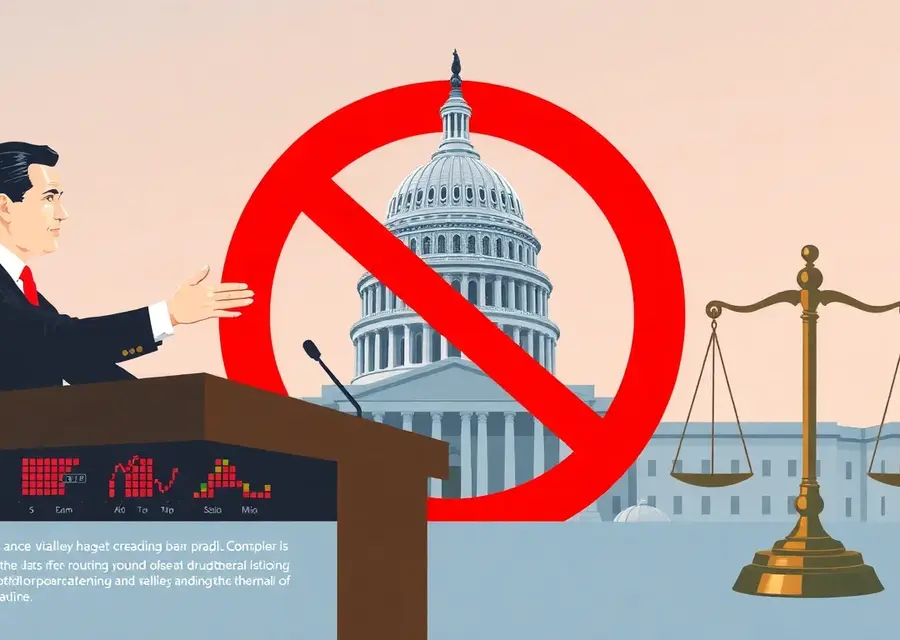Congress Stock Trading Ban: Implications for Markets and Policy
- THE MAG POST

- Sep 7
- 6 min read

congress stock trading ban has emerged as a focal point in Washington, placing lawmakers at the intersection of policy ambition and market credibility. As debates unfold over whether public service should be insulated from personal financial interests, investors watch for signals about accountability, transparency, and the speed of reform. The conversations extend beyond Capitol Hill to financial markets, where expectations about governance can shift risk premiums and volatility. In this piece, we assess the arguments on both sides, explore practical enforcement questions, and sketch how any ban could reshape incentives for policymakers and the information economy around policy-making.
Shutdown Stakes and Market Sentiment
Markets watch the clock when the government shutters; timing often matters more than rhetoric.
Political Risk and Timing
The looming deadline of Oct. 1 for funding bills has sharpened focus on who bears the political load as lawmakers debate a shutdown. In this environment, even modest policy shifts can swing volatility, because traders price not just policy outcomes but the credibility of institutions. The administration’s unilateral moves earlier in the year underscored how Executive actions can intensify partisan signals, complicating risk assessments for corporates, lenders, and households who gauge fiscal stability amid a fraught budget process.
Partisan standoffs tend to amplify narrative risk: when incentives clash, markets react to perceived willingness to compromise rather than to the specifics of spending math. Investors monitor committee calendars, budget expirations, and the public posture of leaders because those signals influence currency strength, debt yields, and credit conditions across the economy. The result is a feedback loop where political anxiety itself becomes a market variable that traders continuously price into asset prices.
Investor Reactions and Market Signals
Even absent a formal deal, markets adjust pricing in anticipation of outcomes; equities may underperform on duration risk, while Treasury securities may gain from flight-to-safety dynamics. Sectors dependent on government spending—defense, infrastructure, healthcare—often exhibit idiosyncratic moves tied to spending judgments and the timing of appropriations. In short, the shutdown narrative can reallocate risk budgets across portfolios more than it alters the baseline cash flows of most firms, making risk budgeting a central exercise for asset allocators.
From a technical standpoint, implied volatility and correlation matrices tend to wander higher near deadlines, offering both risks and opportunities for experienced traders. As headlines fluctuate between brinkmanship and procedural votes, risk premium discipline matters: investors demand clarity on when and how funding will resume, and that demand reshapes implied rates and equity risk premia across the curve, sometimes producing short-lived mispricings that savvy traders can exploit with discipline.
Policy Debate: The Congress Stock Trading Ban Question
The heart of the current debate is not just a ban in theory but its design, scope, and enforcement in practice.
Pros and Cons from Proponents
Supporters argue that a Congress stock trading ban would reduce conflicts of interest, restore public trust, and shield policy outcomes from private trading signals. By constraining individual securities trades, proponents contend the legislative process would gain credibility and minimize perceptions of favoritism, particularly during sensitive negotiations on taxes, defense, or entitlements. Some proposals would allow broad participation through mutual funds and ETFs, preserving financial literacy while limiting direct exposure to single stocks.
Opponents warn about practicalities: enforcement complexity, administrative costs, and the risk of stifling talent or pushing political careers abroad. Critics also suggest that a ban could complicate compensation designs for members who rely on market-based tools to steward portfolios and may trigger unintended consequences in global markets where lawmakers interact with international investors. The overall effect on democratic accountability remains a central point of contention.
Enforcement, Penalties, and Compliance Realities
Proposed enforcement typically includes a defined divestment window—for example, 180 days—to unwind existing holdings, with penalties for violations and disgorgement of ill-gotten gains. Allowances for broad funds would require clear rules to prevent circumvention through pooled investments, and robust disclosure standards would be essential to maintain transparency. Accountability mechanisms would aim to deter insider advantages while preserving public confidence in the legislative process.
Yet, real-world compliance faces hurdles: cross-agency coordination, privacy protections, and the fine line between permissible investment activity and prohibited conduct. Determining intent and defining a breach of fiduciary duty in a political context pose nontrivial legal questions. Moreover, the political optics of enforcement—who bears the brunt, how swiftly penalties are applied—will shape the political will to implement and sustain any ban over time.
Pathways to Legislation: From Drafts to Debates
Legislative design matters as much as the idea itself; therefore, careful architectural choices will determine how a ban would function in practice.
Legislative Hurdles
Any ban must pass through a landscape of competing interests, budgetary concerns, and electoral calculations. Key hurdles include reaching bipartisan agreement on scope, defining permissible investment alternatives, and reconciling differences across chambers. The political economy of reform—who wins and who bears costs—will shape the speed and durability of any proposal, with committees and leadership teams playing decisive roles in shaping the final text.
Additionally, the timing of hearings and the coordination with ethics oversight bodies will influence not only the legislation’s content but also its downstream administration. Stakeholders will demand clarity on enforcement budgets, personnel, and the practicalities of monitoring the trading activity of hundreds of members and staff across multiple jurisdictions.
Bipartisan Dynamics and Timing
Despite deep partisan divides, some lawmakers see potential for a narrow, phased approach that targets the most obvious conflicts while preserving market participation for broader portfolios. The speed of agreement will hinge on whether negotiators can establish credible enforcement benchmarks, transparent reporting, and a workable transition path for those already invested in securities. The interplay between party dynamics and the executive branch’s stance will be instrumental in determining whether a final bill gains momentum or stalls in committee rooms.
Market signals may influence timing as well: if lawmakers perceive that adoption is imminent, committees might accelerate work to avert a political pivot or a procedural delay. Conversely, a protracted process could intensify uncertainty, prompting speculation about alternative regulatory routes or executive actions that could emerge outside Congress.
What These Moves Mean for Markets and Governance
Policy proposals framed around ethics and transparency carry material implications for both markets and public governance. The balance between safeguarding integrity and preserving the dynamism of financial markets will be tested as debates move from conceptual to operational detail.
Short-Term Impacts
In the near term, market volatility may spike as investors weigh the likelihood of a ban, the durability of enforcement, and the broader political climate. Equity sectors sensitive to fiscal policy and regulatory changes could experience heightened price swings, while short-term bonds might react to shifting expectations about government liquidity and debt management. Trading desks will parse committee calendars and media cues for potential inflection points.
News of any tentative agreement or renewed stalemate can trigger immediate repricing across assets, as market participants adjust risk premia to reflect new probabilities of policy outcomes. The net effect is often a richer dispersion of returns across asset classes, underscoring the importance of disciplined risk management and scenario planning for institutional portfolios.
Long-Term Accountability and Trust
Over the longer horizon, a well-designed framework could reinforce accountability by aligning incentives with public interest and sharpening the clarity around conflicts of interest. Transparency gains may improve governance metrics, potentially reducing reputational risk for both lawmakers and the institutions that depend on stable policy environments. Yet, sustainability will require ongoing oversight, periodic reevaluation, and a broad-based consensus that evolves with market innovations and political realities.
Ultimately, the success of any congressional reform hinges on clear rules, effective enforcement, and continued public engagement. If investors and citizens perceive the regime as fair, predictable, and proportionate to risk, the policy shift could strengthen confidence in both markets and government institutions, even as debates continue about the best path forward.
Key Takeaways
Summary of Lessons
The discussion around a congress stock trading ban centers on reducing conflicts of interest while maintaining an operational and fair legislative process. Design choices—scope, enforcement, and transition provisions—will determine both political feasibility and market impact. Short-term trading dynamics respond to headlines and deadlines; long-term outcomes depend on credible governance reforms that survive political cycles and market shifts. A balanced approach can enhance trust without compromising the functional needs of lawmakers or the robustness of financial markets.
As with any significant regulatory shift, ongoing oversight and adaptive governance will be essential. The most successful models combine transparent rules, practical enforcement mechanisms, and clear communication that helps citizens and investors understand how public service is protected from personal financial motives while preserving the innovation and efficiency that dynamic markets require.
What to Watch Next
Key indicators to monitor include committee activity, the timing of funding votes, and any bipartisan coalitions that materialize around enforcement provisions. Market participants will focus on debt yields, volatility indices, and sector-specific reactions tied to anticipated policy outcomes. Public discourse and media coverage will continue shaping expectations about when and how a ban might be enacted, tested, and refined in practice.
Topic | Key Takeaways |
Shutdown Timing | Deadline-driven market sensitivity; timing governs risk sentiment. |
Trading Ban Debate | Policy design, enforcement, and stakeholder costs shape viability. |
Market Signaling | Volatility and risk premia shift with political cues and budget news. |
Governance Outcomes | Trust and accountability hinge on clear rules and credible enforcement. |






















































Comments